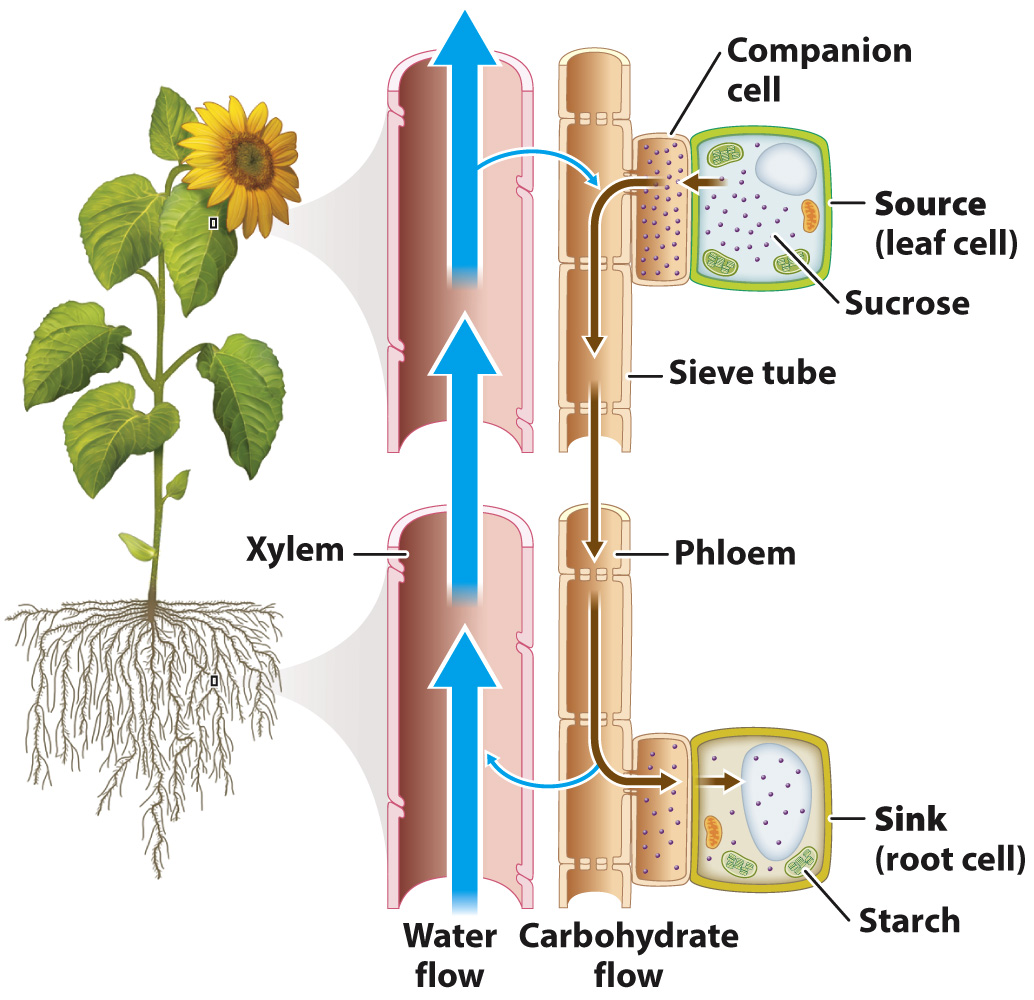Carbohydrates are pushed through phloem by an osmotic pump.
How does phloem transport sugars from source to sink? The overall mechanism results from the buildup of sugars in sources relative to a lower concentration of sugars in sinks. In sources, a high concentration of sugars in sieve tubes causes water to be drawn into the phloem by osmosis. Because the cell walls of the sieve tube resist being stretched outward, the turgor pressure (Chapter 5) at the source end increases. At sinks, sugars are transported out of the phloem into surrounding cells. This withdrawal of sugars causes water to leave the sieve tube, again by osmosis, reducing turgor pressure at the sink end. It is the difference in turgor pressure that drives the movement of phloem sap from source to sink (Fig. 29.15).

612
In some plants, sugars are actively transported into sieve tubes using energy from ATP. In others, sugars diffuse passively from the sites of photosynthesis into the sieve tubes as the sugar concentration builds up in photosynthesizing cells. These mechanisms are quite effective. The pressures that develop in sieve tubes are approximately 100 times the pressures that occur in our own circulatory system.
The water that exits the phloem can remain within the sink or it can be carried back to the leaves in the xylem (Fig. 29.15). The volume of water that moves through the phloem, however, is tiny compared to the amount that must be transported through the xylem to replace water lost by transpiration. Therefore, the number and size of xylem conduits greatly exceeds the number and size of sieve tubes.
Like the xylem, the phloem is subject to risks that arise from the way the flow is generated. The contents of damaged sieve tubes can leak out, pushed by high turgor pressures in the phloem. Damage is an ever-
Quick Check 4 How is phloem able to transport carbohydrates from the shoot to the roots, as well as from the roots to the shoot (although not at the same time)?
Quick Check 4 Answer
The carbohydrates in phloem move from source to sink due to a difference in turgor pressure. In sources, a high concentration of sugars in sieve tubes causes water to flow in by osmosis, increasing turgor pressure. In sinks, sugars are transported out of sieve tubes and used by surrounding cells. The withdrawal of sugar from sieve tubes causes water to flow out of the sieve tube, by osmosis, lowering the turgor pressure. It is the difference in turgor pressure between sources and sinks that drives the movement of phloem sap through sieve tubes. Sources can be actively photosynthesizing leaves, or any organ with a large amount of stored carbohydrates. Carrots are examples of roots with large amounts of stored carbohydrates. In contrast, sinks are organs that require an import of carbohydrates to meet their growth and respiratory needs. Examples of sinks include young leaves, developing fruits, and most roots.